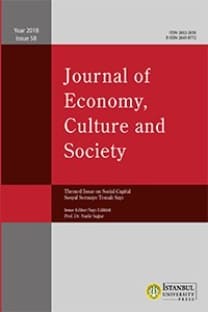Koşullu ve Koşulsuz Kantil Regresyon Modelleri Türkiye’de Ücret Eşitsizliği Hakkında Farklı Ne Söylüyor?
Mincer ücret denklemi, ücret eşitsizliği, koşullu kantil regresyon, koşulsuz kantil regresyon, Türkiye
What Do Conditional and Unconditional Quantile Regression Models Tell Us Something Different About Wage Inequality in Turkey?
Mincer wage equation, wage inequality, conditional quantile regression, unconditional quantile regression, Turkey,
___
- Aeberhardt, R., Givord, P., & Marbot, C. (2011). Minimum wage and wage inequality in France: An unconditional quantile regression approach. Forthcoming in Documents de Travail de la DESE-Working Papers of the DESE. Erişim adresi: http://www.crest.fr/
- Alejo, J., Gabrielli, M., & Sosa-Escudero, W. (2014). The distributive effects of education: An unconditional quantile regression approach. Revista de Análisis Económico–Economic Analysis Review, 29(1), 53–76. http://dx.doi. org/0.4067/S0718-88702014000100003
- Bishop, J., Luo, F., & Wang, F. (2005). Economic transition, gender bias, and the distribution of earnings in China. Economics of Transition, 13(2), 239–259. http://dx.doi.org/10.1111/j.1468-0351.2005.00218.x
- Borah, B., & Basu, A. (2013). Highlighting differences between conditional and unconditional quantile regression approaches through an application to assess medication adherence. Health Economics, 22(9), 1052–1070. http:// dx.doi.org/10.1002/hec.2927
- Buchinsky, M. (1994). Changes in the U.S. wage structure 1963–1987: Application of quantile regression. Econometrica, 62(2), 405–458. http://dx.doi.org/10.2307/2951618
- Buchinsky, M. (1998). Recent advances in quantile regression models: A practical guideline for empirical research. The Journal of Human Resources, 33(1), 88–126. http://dx.doi.org/10.2307/146316
- Çelik, O. ve Selim S. (2014). Türkiye’de kamu ve özel sektör ücret farklılıklarının kantil regresyon yaklaşımı ile analizi. Yönetim ve Ekonomi, 21(1), 205–232. http://dx.doi.org/10.18657/yecbu.26375
- De la Rica, S., Dolado, J., & Llorens, V. (2008). Ceilings or floors? Gender wage gaps by education in Spain. Journal of Population Economics, 21(3), 751–776. http://dx.doi.org/10.1007/s00148-006-0128-1
- Firpo, S., Fortin, N., & Lemieux, T. (2009). Unconditional quantile regression. Econometrica, 77(3), 953–973. http:// dx.doi.org/10.3982/ECTA6822
- Fournier, J., & Koske, I. (2012). The determinants of earnings inequality: evidence from quantile regressions. OECD Journal: Economic Studies, 2012(1). http://dx.doi.org/10.1787/19952856
- Güriş, S., Çağlayan, E., & Saçaklı Saçıldı, İ. (2010). Schooling and wage distribution for male and female employees in the public and private sector. International Research Journal of Finance and Economics, 40, 146–154.
- Güriş, S., Çağlayan, E., & Saçaklı, İ. (2009). Education, experience and male-female wage differentials after 2001 crisis. Öneri Dergisi, 8(31), 259–270. http://dx.doi.org/10.14783/maruoneri.678684
- Hampel, F., Rochetti, E., Rousseeuw, P., & Stahel, W. (1986). Robust Statistics: The Approach Based on Influence Functions. New York, NY: John Wiley & Sons.
- Hao, L., & Naiman, D. Q. (2007). Quantile regression. United States of America, USA: Sage Publications.
- Jarque, C., & Bera, A. (1987). A test for normality of observations and regression residuals. International Statistical Review, 55(2), 163–172. http://dx.doi.org/10.2307/1403192
- Koenker, R. (2005). Quantile Regression (Econometric Society Monographs). Cambridge: Cambridge University Press. http://dx.doi.org/10.1017/CBO9780511754098
- Koenker, R., & Bassett, G. (1978). Regression quantiles. Econometrica, 46(1), 33–50. http://dx.doi. org/10.2307/1913643
- Machado, J., & Mata, J. (2001). Earning functions in Portugal 1982-1994: Evidence from quantile regressions. Empirical Economics, 26(1), 115–134. http://dx.doi.org/10.1007/s001810000049
- MacKinnon, J., & White, H. (1985). Some heteroskedasticity consistent covariance matrix estimators with improved finite sample properties. Journal of Econometrics, 29(3), 305–325. http://dx.doi.org/10.1016/0304- 4076(85)90158-7
- Maclean, J., Webber, D., & Marti, J. (2014). An application of unconditional quantile regression to cigarette taxes. Journal of Policy Analysis and Management, 33(1), 188–210. http://dx.doi.org/10.1002/pam.21724
- Mincer, J. (1974). Schooling, experience and earnings. New York, NY: National Bureau of Economic Research.
- Montenegro, C. (2001). Wage distribution in Chile: does gender matter? A quantile regression approach. Policy Research Report on Gender and Development, Working Paper Series 20. Erişim adresi: https://citeseerx.ist. psu.edu/
- OECD. (2021, 3 Ocak). Income inequality (indicator). Erişim adresi: http://dx.doi.org/10.1787/459aa7f1-en
- Polachek, S. (2008). Earnings over the life cycle: The Mincer earnings function and its applications. Foundations and Trends in Microeconomics, 4(3), 165–272. http://dx.doi.org/10.1561/0700000018
- Rahona-López, M., Murillo-Huertas, I., & Salinas-Jiménez, M. (2016). Wage differentials by sector and gender: a quantile analysis for the Spanish case. Journal of Economic Policy Reform, 19(1), 20–38. http://dx.doi.org/10.1 080/17487870.2015.1028936
- Tang, Y., & Long, W. (2013). Gender earnings disparity and discrimination in urban china: Unconditional quantile regression. African Journal of Science, Technology, Innovation and Development, 5(3), 202–212. http://dx.doi. org/10.1080/20421338.2013.796743
- Tansel, A., & Acar, E. O. (2016). The formal/informal employment earnings gap: Evidence from Turkey. In J. A. Bishop & J. G. Rodríguez (Eds.) Inequality after the 20th century: Papers from the Sixth ECINEQ Meeting (Research on economic inequality, Vol. 24) (pp. 121–154). Bingley: Emerald Group Publishing Limited. http:// dx.doi.org/10.1108/S1049-258520160000024006
- Tansel, A., & Bodur, F. (2012). Wage inequality and returns to education in Turkey: A quantile regression analysis. Review of Development Economics, 16(1), 107–121. http://dx.doi.org/10.1111/j.1467-9361.2011.00655.x
- White, H. (1980). A heteroskedasticity-consistent covariance matrix estimator and a direct test for heteroskedasticity. Econometrica, 48(4), 817–838. http://dx.doi.org/10.2307/1912934
- Yu, K., Lu, Z., & Stander, J. (2003). Quantile regression: Applications and current research areas. Journal of the Royal Statistical Society, 52(3), 331–350. http://dx.doi.org/10.1111/1467-9884.00363
- ISSN: 2602-2656
- Yayın Aralığı: Yılda 2 Sayı
- Başlangıç: 1960
- Yayıncı: İstanbul Üniversitesi Yayınevi
Türkiye’de Akademik Başarının Belirleyicileri
Eren SUNA, Mahmut ÖZER, Sadri ŞENSOY, Bekir S. GÜR, Prof. Dr. Selahattin GELBAL, Petek AŞKAR
Özgür TOPKAYA, Abdurrahman BENLİ, Gökçe CEREV
Kentsel Yaşam Kalitesi Ölçümlerinde Kavramsal Değerlendirmeler ve Boyut Önerileri
Yıldız AKPOLAT, Füsun KÖKALAN ÇIMRIN, Aykut ÇALIŞKAN
Türkiye’de Göç ile Doğurganlık Arasındaki Mekânsal İlişkinin Adaptasyon Hipotezi Açısından Analizi
Naif KARA, Kadriye KOBAK, Aslı İGİT
COVID-19 Salgını Döneminde Ev İşçilerinin Derinleşen Sorunları: İstanbul Örneği
Yuriy LUPENKO, Svitlana ANDROS, Andriy LUPENKO, Yurii YARMOLENKO
Türkiye’de Kadının İşgücüne Katılımı ve Eşitsizlik
Günümüz Çalışma Rejiminde Uykunun İkircikli Konumu: Kavramsal Bir Tartışma
